剑桥少儿英语预备级颜色公开课
- 格式:ppt
- 大小:878.00 KB
- 文档页数:12

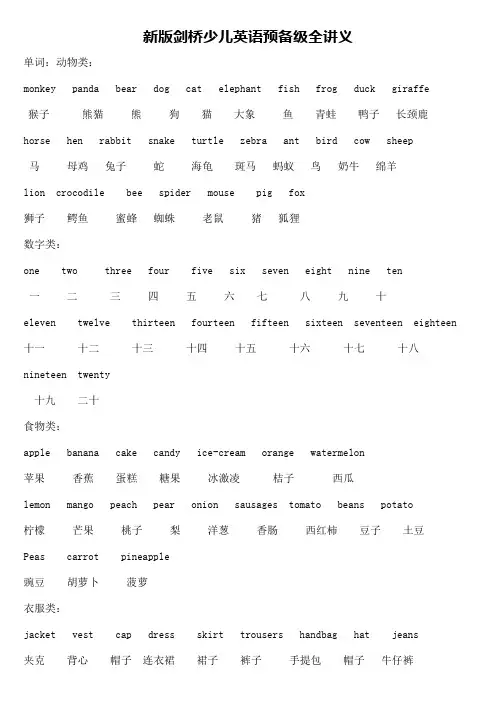
新版剑桥少儿英语预备级全讲义单词:动物类:monkey panda bear dog cat elephant fish frog duck giraffe猴子熊猫熊狗猫大象鱼青蛙鸭子长颈鹿horse hen rabbit snake turtle zebra ant bird cow sheep马母鸡兔子蛇海龟斑马蚂蚁鸟奶牛绵羊lion crocodile bee spider mouse pig fox狮子鳄鱼蜜蜂蜘蛛老鼠猪狐狸数字类:one two three four five six seven eight nine ten一二三四五六七八九十eleven twelve thirteen fourteen fifteen sixteen seventeen eighteen 十一十二十三十四十五十六十七十八nineteen twenty十九二十食物类:apple banana cake candy ice-cream orange watermelon苹果香蕉蛋糕糖果冰激凌桔子西瓜lemon mango peach pear onion sausages tomato beans potato柠檬芒果桃子梨洋葱香肠西红柿豆子土豆Peas carrot pineapple豌豆胡萝卜菠萝衣服类:jacket vest cap dress skirt trousers handbag hat jeans夹克背心帽子连衣裙裙子裤子手提包帽子牛仔裤socks shorts shoes glasses shirt袜子短裤鞋子眼镜衬衫颜色类:green pink yellow black red blue orange white grey purple 绿色粉红色黄色黑色红色蓝色橙色白色灰色的紫色brown棕色地点类:house classroom sea swimming-pool beach street park bookshop房子教室大海游泳池海滩街道公园书店bus-stop farm zoo playground kindergarten school公共汽车站农场动物园操场幼儿园学校房间类: kitchen bathroom living room dining room bedroom 厨房浴室客厅餐厅卧室球类:basketball football badminton baseball篮球足球羽毛球棒球身体类:hair mouth eye nose foot leg arm ear hand head 头发嘴眼睛鼻子脚腿胳膊耳朵手头动作类:bike-ride swim skate watch TV hop jump touch catch paint骑自行车游泳滑冰看电视单脚跳跳跃接触赶上油漆draw bounce run write read dance sleep画弹跳跑写读跳舞睡觉动作短语:take a bath have supper brush teeth climb the tree 洗个澡吃晚饭刷牙爬上树交通工具类 :bike bus car jeep plane ship boat train 自行车公共汽车小轿车吉普车飞机轮船小船火车日常用品类:kite lamp umbrella yo-yo ball tree doll mirror 风筝灯雨伞悠悠球球树洋娃娃镜子Watch camera观察照相机一、反义词:big------small happy------sad left------right young------old 大小快乐难过左边右边年轻的年老的hot------cold quick------slow tall------short long------short 热寒冷快的慢的高的矮的长的短的二、人称代词:I we you he she it they you我我们你他她它他们你们五、物主代词:my your his her our their its我的你的你们的他的她的我们的他们的它的六、句型:1、Do you like apples Yes; I do .你喜欢吃苹果吗是的;我喜欢..Take one ; please . Thank you .拿一个;请.. 谢谢2、Do you like lemons No ; I don’t .你喜欢柠檬吗不;我不要..I’m sorry . Thank you just the same我很抱歉.. 我还是要谢谢你3、What is it It‘s a frog .这是什么这是一只青蛙呢4、What are they They are rabbits它们是什么他们是兔子5、What is red The car is red .什么是红色的吗汽车是红色的6、Which is a school This is a school .这是一个学校这是一个学校..7、Where is the bookshop It’s here .书店在哪里吗它在这里..8、How many pandas are there There are six .有几只大熊猫有六个..9、How many lions can you see I can see two .你能看见多少狮子吗我可以看到两个.. 10、What do you like doing I like running .你喜欢做什么我喜欢跑步..。
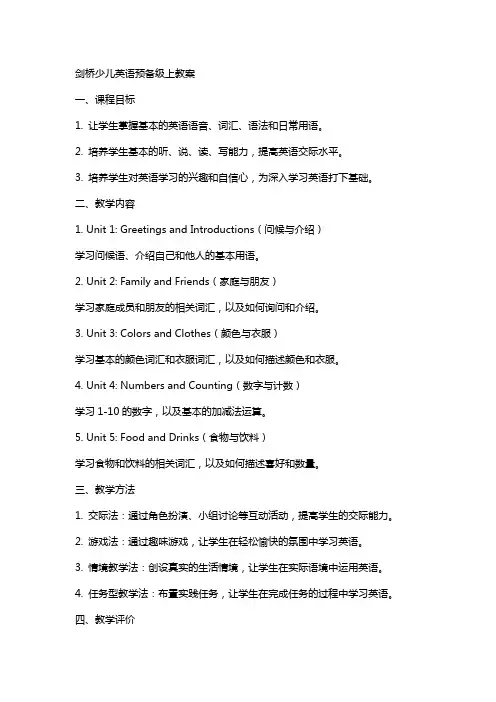
剑桥少儿英语预备级上教案一、课程目标1. 让学生掌握基本的英语语音、词汇、语法和日常用语。
2. 培养学生基本的听、说、读、写能力,提高英语交际水平。
3. 培养学生对英语学习的兴趣和自信心,为深入学习英语打下基础。
二、教学内容1. Unit 1: Greetings and Introductions(问候与介绍)学习问候语、介绍自己和他人的基本用语。
2. Unit 2: Family and Friends(家庭与朋友)学习家庭成员和朋友的相关词汇,以及如何询问和介绍。
3. Unit 3: Colors and Clothes(颜色与衣服)学习基本的颜色词汇和衣服词汇,以及如何描述颜色和衣服。
4. Unit 4: Numbers and Counting(数字与计数)学习1-10的数字,以及基本的加减法运算。
5. Unit 5: Food and Drinks(食物与饮料)学习食物和饮料的相关词汇,以及如何描述喜好和数量。
三、教学方法1. 交际法:通过角色扮演、小组讨论等互动活动,提高学生的交际能力。
2. 游戏法:通过趣味游戏,让学生在轻松愉快的氛围中学习英语。
3. 情境教学法:创设真实的生活情境,让学生在实际语境中运用英语。
4. 任务型教学法:布置实践任务,让学生在完成任务的过程中学习英语。
四、教学评价1. 课堂表现:观察学生在课堂上的参与程度、发音准确性等。
2. 作业完成情况:检查学生作业的完成质量、及时性等。
3. 单元测试:定期进行单元测试,评估学生的学习效果。
4. 期末考试:进行全面考核,检验学生的综合英语水平。
五、教学资源1. 教材:剑桥少儿英语预备级上教材。
2. 课件:利用多媒体课件,辅助教学。
3. 录音机、音响等音响设备:用于播放听力材料。
4. 实物、图片等教学道具:用于直观展示教学内容。
5. 网络资源:搜索相关英语学习网站,丰富教学内容。
六、教学计划1. 每周安排两节正课,每节课时40分钟。

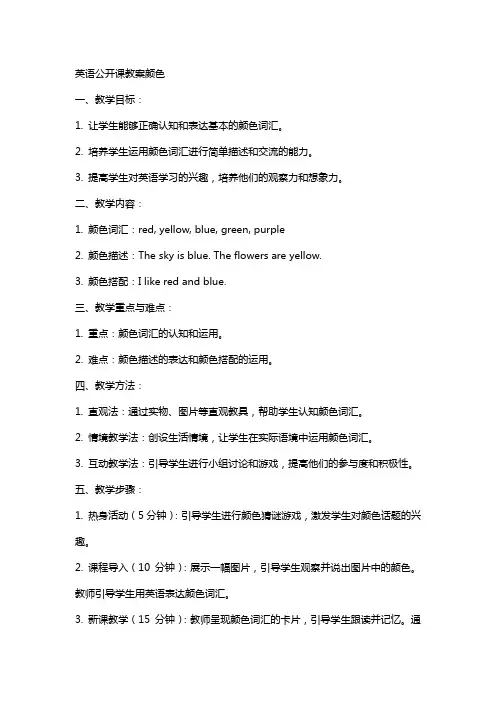
英语公开课教案颜色一、教学目标:1. 让学生能够正确认知和表达基本的颜色词汇。
2. 培养学生运用颜色词汇进行简单描述和交流的能力。
3. 提高学生对英语学习的兴趣,培养他们的观察力和想象力。
二、教学内容:1. 颜色词汇:red, yellow, blue, green, purple2. 颜色描述:The sky is blue. The flowers are yellow.3. 颜色搭配:I like red and blue.三、教学重点与难点:1. 重点:颜色词汇的认知和运用。
2. 难点:颜色描述的表达和颜色搭配的运用。
四、教学方法:1. 直观法:通过实物、图片等直观教具,帮助学生认知颜色词汇。
2. 情境教学法:创设生活情境,让学生在实际语境中运用颜色词汇。
3. 互动教学法:引导学生进行小组讨论和游戏,提高他们的参与度和积极性。
五、教学步骤:1. 热身活动(5分钟):引导学生进行颜色猜谜游戏,激发学生对颜色话题的兴趣。
2. 课程导入(10分钟):展示一幅图片,引导学生观察并说出图片中的颜色。
教师引导学生用英语表达颜色词汇。
3. 新课教学(15分钟):教师呈现颜色词汇的卡片,引导学生跟读并记忆。
通过例句展示颜色描述的用法,让学生进行模仿和练习。
4. 小组活动(10分钟):学生分组进行颜色搭配游戏,鼓励他们用英语进行交流和表达。
教师巡回指导,纠正发音并给予鼓励。
5. 总结与作业(5分钟):教师引导学生回顾本节课所学内容,强调颜色词汇的运用。
布置作业:用英语写一篇关于颜色的短文。
6. 课后反思(5分钟):教师总结课堂教学效果,反思教学方法,为下一步教学做好准备。
六、教学拓展:1. 颜色词汇的扩展:orange, purple, pink, brown, gray, black, white2. 颜色描述的拓展:The cat is black. The sun is setting, and the sky is turning orange.3. 颜色搭配的拓展:I prefer blue and green. What about you?七、教学评价:1. 课堂参与度:观察学生在课堂上的发言和互动情况,评估他们的参与度。
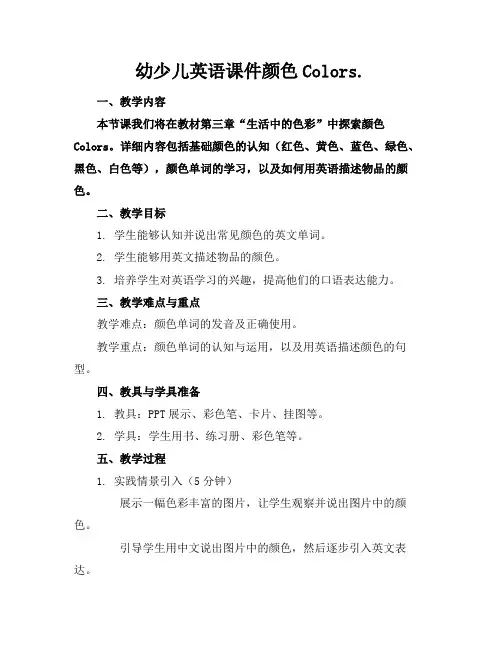
幼少儿英语课件颜色Colors.一、教学内容本节课我们将在教材第三章“生活中的色彩”中探索颜色Colors。
详细内容包括基础颜色的认知(红色、黄色、蓝色、绿色、黑色、白色等),颜色单词的学习,以及如何用英语描述物品的颜色。
二、教学目标1. 学生能够认知并说出常见颜色的英文单词。
2. 学生能够用英文描述物品的颜色。
3. 培养学生对英语学习的兴趣,提高他们的口语表达能力。
三、教学难点与重点教学难点:颜色单词的发音及正确使用。
教学重点:颜色单词的认知与运用,以及用英语描述颜色的句型。
四、教具与学具准备1. 教具:PPT展示、彩色笔、卡片、挂图等。
2. 学具:学生用书、练习册、彩色笔等。
五、教学过程1. 实践情景引入(5分钟)展示一幅色彩丰富的图片,让学生观察并说出图片中的颜色。
引导学生用中文说出图片中的颜色,然后逐步引入英文表达。
2. 例题讲解(10分钟)通过PPT展示,讲解颜色单词的发音和拼写。
举例说明如何用英文描述物品的颜色。
3. 随堂练习(10分钟)分组让学生用彩色笔在卡片上画出自己喜欢的颜色,并用英文描述。
老师选取几个学生的作品进行展示,并让其他学生猜测卡片上的颜色。
4. 小组活动(15分钟)学生分组,每组选择一个颜色主题,用彩色笔在纸上画出与主题相关的图画。
每组派代表展示作品,并用英文介绍。
老师对学生的表现进行点评,强调颜色单词的正确发音和用法。
对学生进行鼓励,提高他们对英语学习的兴趣。
六、板书设计1. 颜色单词列表:红色(red)、黄色(yellow)、蓝色(blue)、绿色(green)、黑色(black)、白色(white)等。
2. 描述颜色的句型:The apple is red.(这个苹果是红色的。
)七、作业设计1. 作业题目:用英文描述自己喜欢的水果或物品的颜色。
答案示例:My favorite fruit is an orange. It's round and the color is orange.2. 画一幅自己喜欢的颜色的图画,并用英文描述。
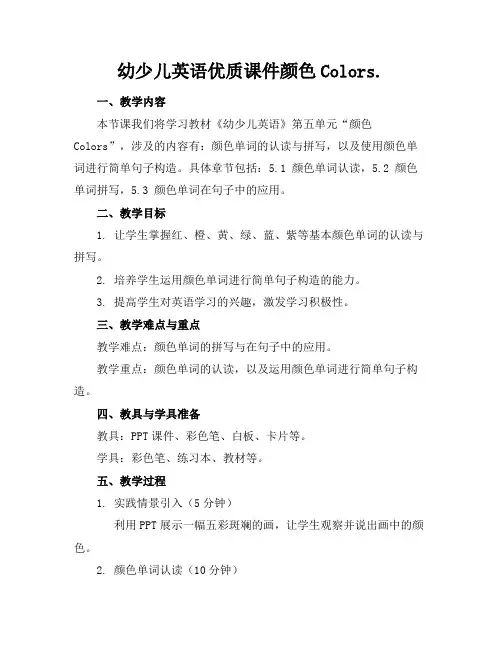
幼少儿英语优质课件颜色Colors.一、教学内容本节课我们将学习教材《幼少儿英语》第五单元“颜色Colors”,涉及的内容有:颜色单词的认读与拼写,以及使用颜色单词进行简单句子构造。
具体章节包括:5.1 颜色单词认读,5.2 颜色单词拼写,5.3 颜色单词在句子中的应用。
二、教学目标1. 让学生掌握红、橙、黄、绿、蓝、紫等基本颜色单词的认读与拼写。
2. 培养学生运用颜色单词进行简单句子构造的能力。
3. 提高学生对英语学习的兴趣,激发学习积极性。
三、教学难点与重点教学难点:颜色单词的拼写与在句子中的应用。
教学重点:颜色单词的认读,以及运用颜色单词进行简单句子构造。
四、教具与学具准备教具:PPT课件、彩色笔、白板、卡片等。
学具:彩色笔、练习本、教材等。
五、教学过程1. 实践情景引入(5分钟)利用PPT展示一幅五彩斑斓的画,让学生观察并说出画中的颜色。
2. 颜色单词认读(10分钟)(1)教师展示教材中的颜色单词,引导学生跟读。
(2)教师挑选几个颜色单词,让学生模仿并重复。
(3)分组进行颜色单词接龙游戏,巩固认读。
3. 颜色单词拼写(10分钟)(1)教师讲解颜色单词的拼写规则。
(2)学生跟随教师一起拼写颜色单词。
(3)学生独立完成拼写练习。
4. 例题讲解(10分钟)教师给出几个例句,如:“This is a red apple.”,引导学生理解并模仿。
5. 随堂练习(10分钟)学生根据教材中的图片,用颜色单词构造句子。
教师带领学生回顾本节课所学内容,并进行拓展,如:讨论其他颜色单词的应用。
六、板书设计1. 颜色单词认读:红、橙、黄、绿、蓝、紫等。
2. 颜色单词拼写:red、orange、yellow、green、blue、purple 等。
3. 例句:This is a red apple.、That is a yellow banana.等。
七、作业设计1. 作业题目:用颜色单词构造5个句子。
答案示例:The sky is blue.、My favorite color is red.等。

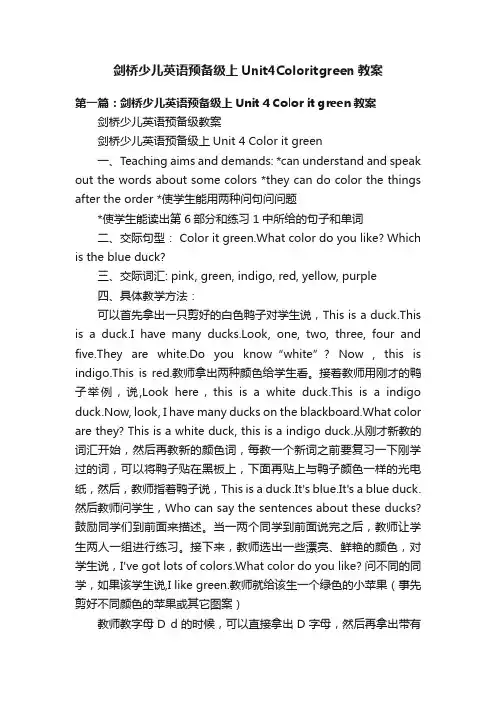
剑桥少儿英语预备级上Unit4Coloritgreen教案第一篇:剑桥少儿英语预备级上Unit 4 Color it green教案剑桥少儿英语预备级教案剑桥少儿英语预备级上Unit 4 Color it green一、Teaching aims and demands: *can understand and speak out the words about some colors *they can do color the things after the order *使学生能用两种问句问问题*使学生能读出第6部分和练习1中所给的句子和单词二、交际句型: Color it green.What color do you like? Which is the blue duck?三、交际词汇: pink, green, indigo, red, yellow, purple四、具体教学方法:可以首先拿出一只剪好的白色鸭子对学生说,This is a duck.This is a duck.I have many ducks.Look, one, two, three, four and five.They are white.Do you know“white”? Now , this is indigo.This is red.教师拿出两种颜色给学生看。
接着教师用刚才的鸭子举例,说,Look here,this is a white duck.This is a indigo duck.Now, look, I have many ducks on the blackboard.What color are they? This is a white duck, this is a indigo duck.从刚才新教的词汇开始,然后再教新的颜色词,每教一个新词之前要复习一下刚学过的词,可以将鸭子贴在黑板上,下面再贴上与鸭子颜色一样的光电纸,然后,教师指着鸭子说,This is a duck.It's blue.It's a blue duck.然后教师问学生,Who can say the sentences about these ducks?鼓励同学们到前面来描述。
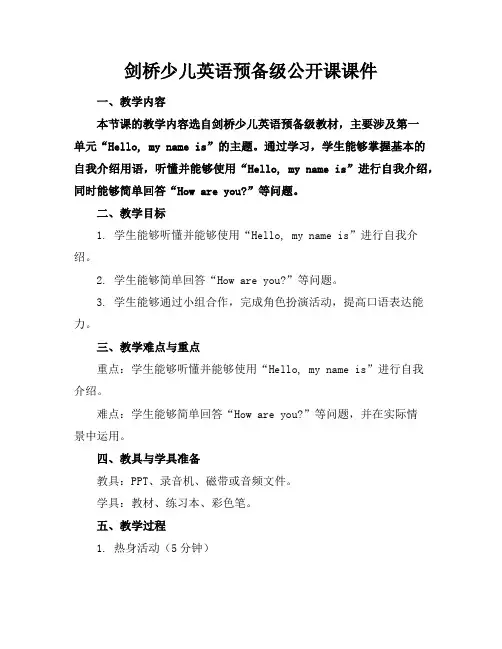
剑桥少儿英语预备级公开课课件一、教学内容本节课的教学内容选自剑桥少儿英语预备级教材,主要涉及第一单元“Hello, my name is”的主题。
通过学习,学生能够掌握基本的自我介绍用语,听懂并能够使用“Hello, my name is”进行自我介绍,同时能够简单回答“How are you?”等问题。
二、教学目标1. 学生能够听懂并能够使用“Hello, my name is”进行自我介绍。
2. 学生能够简单回答“How are you?”等问题。
3. 学生能够通过小组合作,完成角色扮演活动,提高口语表达能力。
三、教学难点与重点重点:学生能够听懂并能够使用“Hello, my name is”进行自我介绍。
难点:学生能够简单回答“How are you?”等问题,并在实际情景中运用。
四、教具与学具准备教具:PPT、录音机、磁带或音频文件。
学具:教材、练习本、彩色笔。
五、教学过程1. 热身活动(5分钟)教师播放英语歌曲,引导学生跟唱,活跃课堂气氛。
然后,教师邀请几名学生进行自我介绍,引入本节课的主题。
2. 新课导入(10分钟)教师通过PPT展示本节课的主要内容,讲解“Hello, my name is”的用法,并让学生跟读。
同时,教师通过例句展示如何回答“How are you?”,让学生进行听力练习。
3. 课堂练习(10分钟)学生分组进行角色扮演,模拟情景,练习自我介绍和回答“Howare you?”。
教师巡回指导,纠正发音,并给予鼓励。
4. 巩固练习(5分钟)教师给出一些简单的听力题目,让学生听录音并回答问题。
例如:“Hello, my name is How are you?”的录音,学生需要根据听力内容,填写空缺的部分。
5. 课堂小结(5分钟)六、板书设计板书内容主要包括本节课的主题“Hello, my name is”和“How are you?”的回答。
教师可以用简洁的词语和图示,帮助学生理解和记忆。

剑桥少儿英语预备级公开课•Course Introduction and Background•Teaching content and methods •Classroom activities and interactive strategies•Homework and tutoring advice •Course evaluation and feedback •Summary and Outlook目录01Course IntroductionandBackgroundIntroduction to Cambridge Children's English SystemThe Cambridge Children's English System is a comprehensive Englishlanguage learning program specifically designed for young learners It aims to develop children's English language skills, including listening,speaking, reading, and writing, through fun and engaging activitiesThe system focuses on practical communication skills and resources childrento use English in real life situationsPositioning and Objectives of Preparatory Courses The preparatory courses are designed to prepare children for theCambridge Children's English System and other English languageprogramsThey focus on building a solid foundation in basic Englishlanguage skills, such as vocabulary, grammar, and promotionThe objectives of the preparatory courses are to help childrendevelop confidence in using English, improve their learningabilities, and enhance their motivation to learnNeeds analysis is conducted to identify each child's level of English proficiency and learning style, allowing for personalized instruction and targeted practiceThe preparatory courses are suitable for children aged 5 to 12 years old who have little or no prior knowledge of English Children in this age group typically have short attention spans and learn best through interactive andplayful activitiesStudent group and needs analysisThe preparatory courses use a variety of textbooks and teaching resources that are specifically designed for young learnersTeachers also have access to a range of supportmaterials, including less plans, activity ideas,and assessment tools to ensure effective andeffective delivery of the course contentThese resources include colorful illustrations,engaging stories, and interactive exercises thatmake learning fun and accessibleOverview of Textbooks and Teaching Resources02Teachingcontent andmethodsKey points of teaching phonetics, vocabulary, and grammarPhoneticsEmphasis on the promotion and introduction ofEnglish sounds, and help students master the basicphone knowledge and skillsVocabularyTeach students high frequency words and phrasesin English, and guide them to learn vocabularythrough context and associationGrammarIntroduce basic English grammar rules andstructures, and help students understand and applythem in practical language useListeningDevelop students' ability to understand spoon English through listening activities such as listening to stories, songs, and dialogues SpeakingEncourage students toexpress themselves inEnglish and improve theiroral communication skillsthrough role plays,discussions, andpresentationsReadingGuide students to readEnglish texts, understand themain ideas, and extract keyinformation through readingcomprehension exercisesWritingHelp students write simpleEnglish texts such as letters,stories, and essays, andimprove their writing skillsthrough writing practice andfeedback01020304Training of listening, speaking, reading, and writing skillsMultimedia teaching and interactive designMultimedia resourcesUtilize multimedia resources such as videos, audiorecordings, and interactive software to enhancestudents' learning experienceInteractive designDesign interactive activities and games that engagestudents in the learning process and make learningmore fun and effectiveThe application of gamified teaching method in preparation levelGamification elementsIncorporate gaming elements such as points, bags, and leaderboardsto motivate students and enhance their learning experiencePreparation level adaptationAdapt the gamified teaching method to the preparation level bydesigning appropriate games and activities that are suitable for younglearners and help them achieve their learning goals03Classroomactivities andinteractivestrategiesDesign and practice of role playing gamesRole allocation and scenario settingAssign roles to students based on their interests and English proficiency, anddesign authentic scenarios to enhance their language integrationLanguage functions and communication skillsFocus on the language functions and communication skills needed for each role,and provide opportunities for students to practice and improve their languageuseTeacher guidance and feedbackProvide guidance and feedback to students during the role playing process,helping them to better understand and master the target languageThe Application of Songs and Children's Rhymes in English TeachingSelection of appropriate songs and rhymesChoose songs and rhymes that are appropriate for the target age group and language level, andensure they are engaging and educationalIntegration into classroom activitiesIntegrate songs and rhymes into various classroom activities, such as warm ups, transitions, andreviews, to enhance students' learning experienceEncouraging student participationEncourage students to actively participate in singing and rhyming activities, and provideopportunities for them to perform in front of the classEstablishment of group cooperation and competition mechanismGroup formation and task allocationForm groups of students based on their abilities and interests, and assigntasks that require cooperation and teamworkCollaborative learning activitiesDesign collaborative learning activities that resource students to worktogether to achieve a common goalCompetition and rewardsIntroduce competition among groups and provide rewards for outstandingperformance to motivate students and enhance their sense of acceptanceEncoding evaluation strategies and implementation effects•Student self-evaluation: Enhance students to reflect on their own performance and identify areas for improvement•Peer evaluation: Provide opportunities for peers to evaluate each other's performance, promoting a sense of community and multiple support•Teacher evaluation and feedback: Regularly evaluate students' progress and provide constructive feedback to help them improve their language skills and learning strategies•Implementation effects: Monitor the implementation effects of the evaluation strategies and adjust as necessary to ensure they are effective in motivating students and improving their language proficiency04Homeworkand tutoringadviceHomework types and diversity settingsDiverse home typesInclude reading comprehension, vocabulary exercises, grammar practice,writing tasks, and oral practice to comprehensively improve children'sEnglish skillsAppropriate diversity levelsSet home diversity levels based on children's English proficiency andlearning objectives, ensuring that they are challenging but achievableEncourage active participation01Encourage children to actively participate in English learningactivities, such as role playing, singing English songs, andwatching English movies Foster autonomous learning02Guide children to develop autonomous learning habits, such assetting learning goals, planning learning time, and self-evaluation progress Provide emotional support03Offer endowment and support to children during the learningprocess, helping them overcome difficulties and build confidence Parental guidance on children's English learning methods01 02 03Quality online resourcesRecommend reproducible online English learning platforms and resources, such as online courses, learning apps, and interactive games, to enhance children's learning experienceOffline learning materialsIntroduce suitable offline learning materials, such as textbooks, workbooks, and reading materials, to complete online learning and provide additional practice opportunitiesBalanced utilizationGuide children to utilize both online and offline resources in a balanced way, taking advantage of the strengths of each to achieve optimal learning outcomesRecommendation and utilization of online and offline resourcesRegular progresstrackingEstablish a regular progress tracking system to monitor children's English learning progress and identify areas needing improvementTimely feedbackProvide timely feedback tochildren on their home andlearning performance, offeringconstructive suggestions andfundingCollaborativecommunicationEncourage opencommunication betweenparents, teachers, and childrento join address learningchallenges and cellularachievementsEstablishing a tracking and feedback mechanism05Course evaluation andfeedbackOral fluency, vocabulary, grammar accuracy, promotion,and ability to understand and respond to questionsOngoing assessments through class participation, home work, quizzes, and tests Regular progress reports provided to parentsAssessment criteria and methods for studentprogressMethodsCriteriaReflecting on teaching methods, classroom management, and student engagement Identifying strengths,weaknesses, and areas forimprovementSetting goals for personaland professionaldevelopmentWriting a self-evaluation report for teachersOpen ended questions allowing parents to providedetailed feedback Analysis of survey results to identify areas needingimprovementQuestions covering current, teaching quality, facilities, and overall satisfaction Design of a Parent Satisfaction Survey Questions naireContinuous improvement direction and measures Regular review of course materials and teaching methods to ensure they are up todate and effectiveOn going teacher training and development to enhance teaching skills andknowledgeCollecting and analyzing feedback from students, parents, and teachers to identifyareas for improvement and implementation changes as needed06Summary andOutlookSuccessful introduction to basic English vocabulary and grammarThrough interactive games and activities, students have acquired a solid foundation in English language fundamentalsEnhanced speaking and listening skillsRegular practice in speaking and listening activities hashelped students develop their communication skillsTHANKS感谢观看。